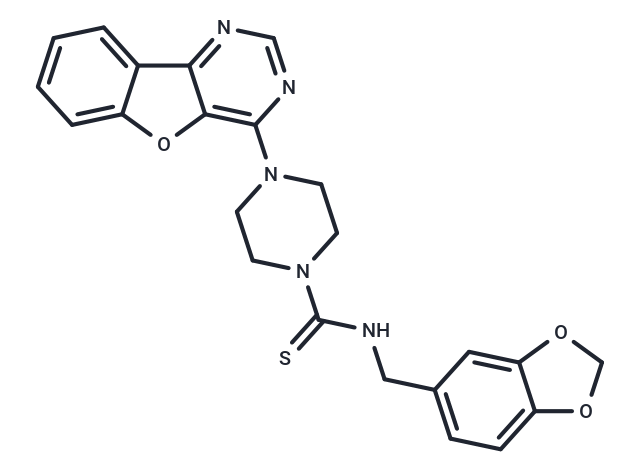Shopping Cart
- Remove All
 Your shopping cart is currently empty
Your shopping cart is currently empty

Amuvatinib (MP470) is an orally bioavailable synthetic carbothioamide with potential antineoplastic activity.

| Pack Size | Price | Availability | Quantity |
|---|---|---|---|
| 1 mg | $44 | In Stock | |
| 2 mg | $62 | In Stock | |
| 5 mg | $93 | In Stock | |
| 10 mg | $150 | In Stock | |
| 25 mg | $275 | In Stock | |
| 50 mg | $441 | In Stock | |
| 100 mg | $556 | In Stock |
| Description | Amuvatinib (MP470) is an orally bioavailable synthetic carbothioamide with potential antineoplastic activity. |
| Targets&IC50 | c-Kit (D816H):10 nM, PDGFRα (V561D):40 nM, FLT3 (D835Y):81 nM |
| In vitro | Tumor growth was inhibited by intraperitoneal injection of 10 mg/kg-75 mg/kg or by oral administration of 50 mg/kg-200 mg/kg MP-470 in a mouse transplantation tumor model harboring HT-29, A549, and SB-CL2 cells.The combination of 20 mg/kg MP-470 and erlotinib markedly inhibited the tumor growth in mice harboring LNCaP transplantation tumors. tumor growth in mice bearing LNCaP graft tumors. |
| In vivo | 1 μM MP-470 inhibited tyrosine phosphorylation of AXL in MDA-MB-231 cells.10 μM MP-470 caused cell cycle arrest in the G1 phase and decreased Akt and ERK1/2 phosphorylation in LNCaP cells.10 μM MP-470 inhibited c-Met phosphorylation in SF767 cells and sensitized the cells to radiation.10 μM MP-470 combined with radiation inhibited GSK-3β activity, induced apoptosis, and disrupted dsDNA b break repair, possibly by inhibiting Rad51. 470 inhibited GSK-3β activity and induced apoptosis in combination with radiation, and disrupted dsDNA b-break repair, possibly by inhibiting Rad51. MP-470 hydrochloride effectively inhibited the proliferation of OVCAR-3, A549, NCI-H647, DMS-153, and DMS-114 cells, with an IC50 of 0.9 μM to 7.86 μM. 7.86 μM. MP-470 was toxic to MiaPaCa-2, PANC-1 and GIST882 cells with IC50s ranging from 1.6 μM to 3.0 μM. MP-470 was toxic to LNCaP and PC-3 but not to DU145 cells with IC50s of 4 μM and 8 μM, respectively, and induced apoptosis at 10 μM. |
| Kinase Assay | Kinase inhibition assay of c-Kit and PDGFRα: For the testing of inhibitory activity against c-Kit and PDGFRα, enzymes are incubated with varying concentrations of MP-470 and radiolabeled γ-32P-ATP. After 30 min, the reaction mixtures are electrophoresed on an acrylamide gel and autophosphorylation, quantitated by the amount of radioactivity incorporated into the enzyme, is assayed. |
| Cell Research | Cells are plated at a density of 2 × 103 to 1 × 104 cells per well in 100 μL medium on day 0 in 96-well Falcon microtitier plates. On day 1, ten μL of serial dilutions of MP-470 are added to the plates in quadruplicates. After incubation for 4 days, the cells are fixed with 10% Trichloroacetic acid solution. Subsequently, they are labeled with 0.04% Sulforhodamine B (SRB) in 1% acetic acid. After multiple washes to remove the excess dye, 100 μL of 50 mM Tris solution is added to each well in order to dissolve the dye. The absorbance of each well is read on a plate reader at 570 nm. Date are expressed as the percentage of survival of control calculated from the absorbance corrected for background absorbance. The surviving percent of cells is determined by dividing the mean absorbance values of the monoclonal antibody by mean absorbance values of the control and multiplying by 100.(Only for Reference) |
| Alias | MP470, HPK 56 |
| Molecular Weight | 447.51 |
| Formula | C23H21N5O3S |
| Cas No. | 850879-09-3 |
| Smiles | C(NCC=1C=C2C(=CC1)OCO2)(=S)N3CCN(C4=C5C(C=6C(O5)=CC=CC6)=NC=N4)CC3 |
| Relative Density. | 1.443 |
| Storage | Powder: -20°C for 3 years | In solvent: -80°C for 1 year | Shipping with blue ice. | |||||||||||||||||||||||||||||||||||
| Solubility Information | DMSO: 50 mg/mL (111.73 mM), Sonication is recommended. Ethanol: < 1 mg/mL (insoluble or slightly soluble) | |||||||||||||||||||||||||||||||||||
Solution Preparation Table | ||||||||||||||||||||||||||||||||||||
DMSO
| ||||||||||||||||||||||||||||||||||||

Copyright © 2015-2025 TargetMol Chemicals Inc. All Rights Reserved.